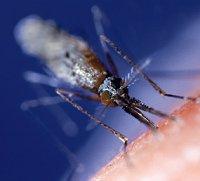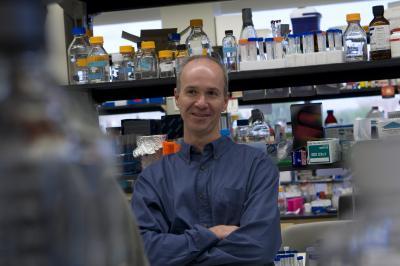from the University of Illinois and his research colleagues have developed a method to produce large quantities of an anti-malarial compound, thereby helping to reduce the cost of treating this disease

Microbiology professor William Metcliffe from the University of Illinois and his research colleagues have developed a method to produce large quantities of an anti-malarial compound, thereby helping to reduce the cost of treating this disease.
The researcher wanted to find out how this compound, one of a wider family called phosphonates, is produced in nature by a bacterium. He was interested in this process because some phosphonates have antibiotic properties. Recently, the researcher and his team were able to identify and sequence the genes of the bacterium and characterize the process by which the bacterium produces this particular phosphonate compound (Simona - FR900098).
Although the compound has already been chemically synthesized, the new process is much cheaper. Through accurate knowledge of the biosynthesis of this compound in the bacterium it is now possible to utilize the cellular mechanism of the bacterium to create the compound in large quantities and at a reasonable cost. "Malaria is a serious problem in third world countries and most antibiotics are expensive," says Metcalf.
With the help of chemical engineering professor Huimin Zhao, efforts have already begun to engineer new strains of the bacterium Escherichia coli that will produce the compound FR900098 in large doses and can be used against malaria.
In addition, says the lead researcher, knowing the genes involved in the process and understanding the pathway that the bacterium uses to prepare this substance mean that the genes can be utilized and changed so that they produce an improved compound that will be more effective against malaria that originates from parasites while being safe for human use.
The need for new antibiotic substances is great and always present because bacteria with resistance to drug combinations are now appearing even outside of medical facilities. As a result, infections that used to be easily treated have become more complex and challenging to eradicate. For example, tuberculosis has become resistant to antibiotics until today "they will send you to the desert to breathe dry air, just like they used to before the discovery of antibiotics," says the lead researcher.
In the case of malaria, the World Health Organization published its annual report for 2008 in which the experts estimate that "half of the world's population is at risk of contracting this disease, and there is an estimate that 247 million cases of it led to the death of 880,000 deaths in 2006."
Resistance to common antimalarial drugs (chloroquine, sulphadoxine-pyrimethamine) is already on the horizon, and mosquitoes are already developing resistance to insecticides. "In my humble opinion, malaria is the biggest infectious disease facing the world," says Metcalf. The current recommendation of the World Health Organization is to treat malaria with a simultaneous combination of drugs in order to fight the ability of the pests to develop resistance against the antibiotic substances.
"In any infection, there is a high probability that one out of ten million pests present in the patient's body will develop resistance to a given drug," says the lead researcher. "Now, if the patient receives a second drug at the same time, one out of ten million pests will develop resistance to it as well. However, the probability that the same pest will develop resistance against the combination of the two drugs together is equal to the product of the individual probabilities, i.e. ten to the fourteenth power."
This approach of combined therapy (combination therapy) is the approach taken today against infectious diseases such as AIDS and tuberculosis and others. In the case of malaria, combined treatment both cures the patient and suppresses the spread of the infection, since the uninfected mosquito can spread the pest by biting an infected person. However, in many places where the disease is localized, this method is not used, partly due to the costs of the various drugs. Making the drugs more economically available will increase the likelihood that they will be used in the most optimal way, that is, through integrated healing.

Metcalf became interested in drugs against malaria due to his interest in phosphonates - compounds that contain a direct chemical bond between a carbon atom and a phosphorus atom (as opposed to the carbon-oxygen-phosphorus bonds that exist in most biological compounds that contain phosphorus). As a doctoral student he characterized how bacteria digest phosphonic acid from the herbicide glyphosate (RoundUp). He began to wonder where this family of materials comes from and how it is produced in nature.
In addition to sequencing the genes responsible for producing the substance FR900098, the researcher and his colleagues are interested in determining the prevalence in nature of these phosphonic acids (phosphonates) that have useful properties against bacteria, fungi and cancer. The scientific community has known since the seventies that bacteria routinely produce these acids that are used as "natural" biological warfare agents.
However, until now no researcher has conducted a systematic test for the discovery and characterization of natural phosphonates. The phosphonates work by disrupting the pathways that use phosphoric esters and organic acids. Each phosphonate disrupts a specific pathway. For example, FR900098 disrupts the pathway for the formation of isoprenoids, building blocks for important cellular components. When the researchers discovered that the substance is capable of disrupting the pathway in those pests that cause malaria, they saw a way to effectively use the new substance. This biosynthetic pathway does not exist in beech, in which there is another method for preparing isoprenoids.
Understanding these pathways "opens a window for finding other antibiotic substances from this family of compounds. The more we increase our understanding of these pathways, the greater our chances of finding unknown phosphonates with antibiotic activity will increase," says the lead researcher.
His laboratory developed a direct method to clone and sequence the genes required for the synthesis of phosphonates in bacteria, making the searches efficient and exhaustive. The lead researcher is optimistic that he and other researchers will be able to develop additional phosphonates as new antibiotic agents.
to the notice of the researchers
More on the science website

2 תגובות
Almost a million people die a year from malaria? That's a lot. I suppose it is essential and part of the regulation of the human population. The problem is that the poor victims are third world people while in the West we have the money and knowledge to control the disease. This creates internal evolution: on the one hand, it develops people more resistant to malaria in the third world, and on the other hand, it violates the quantitative and qualitative balance associated with human biogeography. To survive malaria, once infected, you must be resistant or westernized.
The use of bacteria is always a smart use because we know how to control them well and the rate of creation of mutations in them is mostly to our advantage. Now that the genes have been isolated, it is possible to insert them into coliforms, harvest the material from them and at the same time put them through a process of accelerated evolution (exposure to radiation, for example) and the selection of the most efficient mutants.
This kind of research makes me ponder the question of "where is the human race going".
Best regards,
Ami Bachar